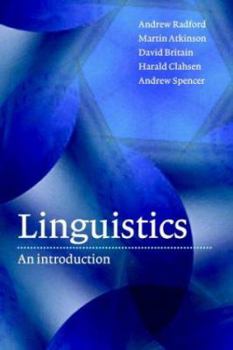Linguistics: An Introduction
Select Format
Select Condition 
Book Overview
Written by a team based at one of the world's leading centres for linguistic teaching and research, the second edition of this highly successful textbook offers a unified approach to language, viewed... This description may be from another edition of this product.
Format:Paperback
Language:English
ISBN:0521478545
ISBN13:9780521478540
Release Date:May 1999
Publisher:Cambridge University Press
Length:452 Pages
Weight:1.60 lbs.
Dimensions:9.3" x 1.0" x 6.3"
Customer Reviews
2 ratings
Response to watzizname's review
Published by Thriftbooks.com User , 21 years ago
The review posted by watzizname slams this book on a few fronts, but the slams are unfounded. Watzizname may be a casual observer of linguistics, but he doesn't seem to know what is going on in the field presently.For example, when referring to case, watzizname says that English no longer uses case, but is a positional language. This is true to some extent, but most contemporary theories of syntax use case as a crucial component, even when the case is not overtly marked (as in English). The Principles and Parameters model of syntax contains the "case filter," where all overt DPs (or Noun Phrases) must be case-marked at Surface Structure, else the sentence is ruled ungrammatical. In the more modern Minimalist Program, uninterpretable case must be "checked." These apply to even non-case languages like English, since they refer to abstract case, not morhpological or "inherent" case. Pronoun case markings are simply the most concrete way of explaining case in English, since we have few morphological reflexes left.The other gripe of watzizname's was that Noun Prases are referred to as Determiner Phrases in the book. Watzizname clearly doesn't know where the theory is nowadays. Noun Phrases are now thought to be embedded withing DPs, with the determiner serving as sort of a 'fuctional shell,' even when there is no overt determiner in the phrase. These function just like the 'light verb' "v" serves as a functional shell for verb phrases and TP/IP/AgrP/CP serve as functional shells for clauses (preveiously termed "S").So, please ignore watzizname's complaints about this book. What he is complaining about actually reflects some of the more recent developments in the fields of syntax and linguistics and should actually be considered PLUSSES for this book, not detractors. Most intro to linguistics textbooks show you where the field was 20 years ago.
A Decent Survey
Published by Thriftbooks.com User , 24 years ago
I found this book to be a decent survey of Linguistics. It is written at a higher level, assuming the reader already knows a bit about language, which I appreciated, yet is not so complex you cannot follow it. Obviously a graduate level read. I recommend it for anyone who is brushing up on linguistics and already has a background in it. It is an overview with more depth than typical linguistics books.






